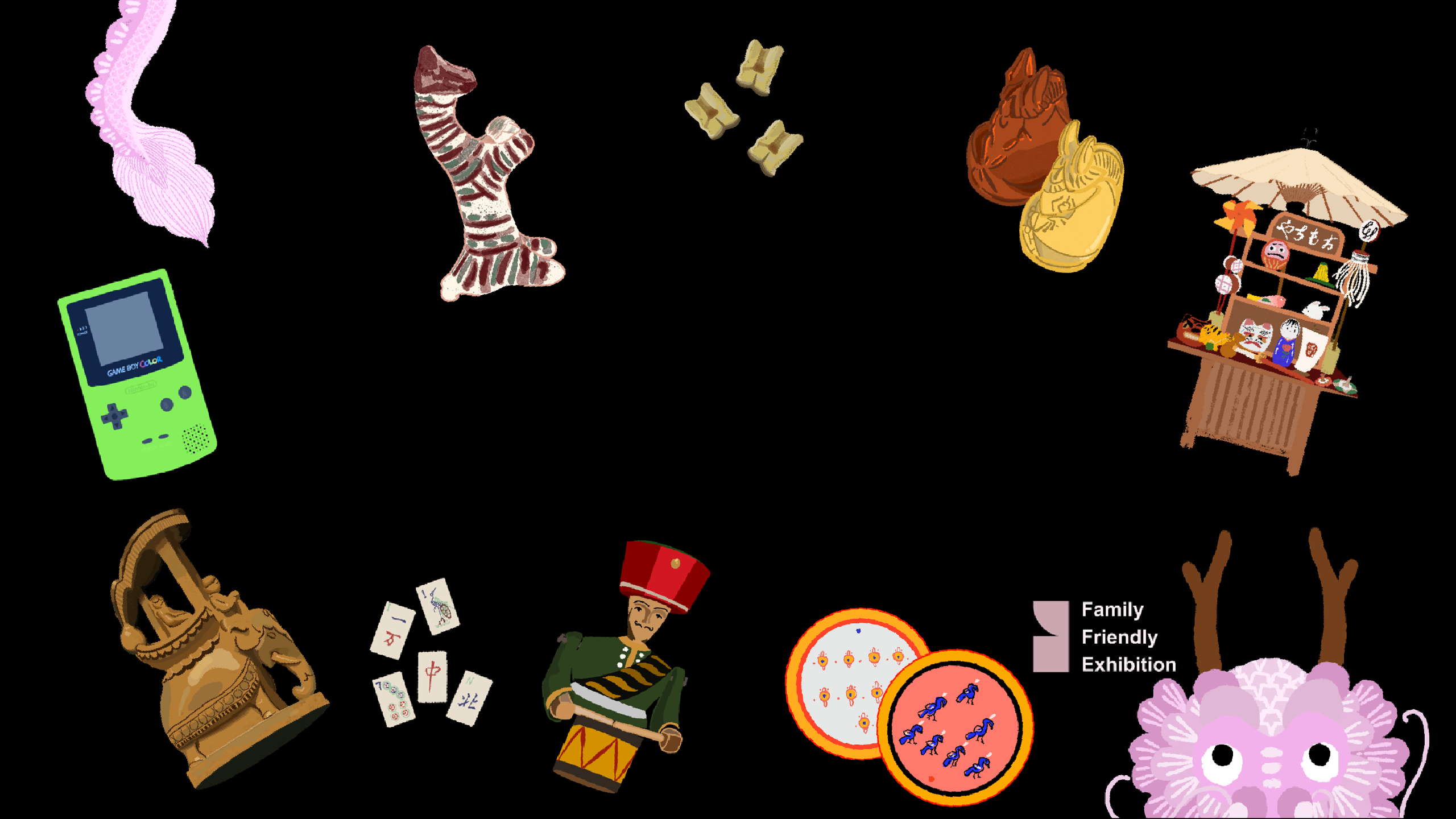Bibliography

Alekseenko, E. A. (2021 [1968]) ‘The Cult of the Bear among the Ket’ in V. Diószegi (ed.) Popular Beliefs and Folklore Tradition in Siberia. Berlin, Boston: De Gruyter Mouton. https://doi.org/10.1515/9783112414545.
Batkalova, K. and Galiev, A (2016). ‘Rites of Passage in Japanese Traditional Culture’. The International Conference on Japan & Japan Studies 2016. Available at: https://papers.iafor.org/wp-content/uploads/papers/iicj2016/IICJ2016_26954.pdf (Accessed 19 May 2024).
Bell, R.C. (1973). Discovering Old Board Games. Shire Publications Ltd. Available at: https://archive.org/details/discoveringoldboO000bell (Accessed 19 Feb. 2024).
Bernard, C. (2014). Karuta: Gotta catch’em all. Available at: https://www.tofugu.com/japan/karuta-japanese-cards/ (Accessed 28 February 2024).
Chen, M. and Cryle, D. (2008). ‘Beijing in preparation for the 2008 Olympics: A study of newspaper content and themes in the People's Daily’. Power and Place: refereed proceedings of the Australian and New Zealand Communication Association Conference, Wellington, New Zealand, 9-11 July. New Zealand: Massey University, pp.1. Available at: https://acquire.cqu.edu.au/articles/conference_contribution/Beijing_in_preparation_for_the_2008_Olympics_a_study_of_newspaper_content_and_themes_in_the_People_s_Daily/13424432 (Accessed 19 May 2024).
Ding, Y. and Thompson, L. (2013) ‘Re-evaluating the Beijing Olympic Fuwa mascots in the circuit of culture’. Asia Pacific Journal of Sport and Social Science, 2(2), pp.87-103.
Dong, J. (2016) ‘Politics and sporting events: Beijing Olympics, 2008’.in Bairner, A., Kelly, J., & Lee, J.W. (eds) Routledge Handbook of Sport and Politics (1st ed.). Oxon and New York: Routledge, p.459-470.
Dulgunn, B. (2019) New campaign draws attention to Mongolian traditional games, The UB Post, 30 October. Available at: https://www.pressreader.com/mongolia/the-ub-post/20191030/281655371867798. (Accessed 15 February 2024).
Gerelee (2020) ‘Traditional Games of Mongolia’. Mongolian Culture blog, 8 September. Available: https://www.amicusmongolia.com/traditional-games-mongolia-toys.html (Accessed 15 February 2024).
Gilchrist, C. (2009) Russian Magic: Living Folk Traditions of an Enchanted Landscape. Wheaton: Quest Books.
Haney, J. V. (eds) (1999) Russian Animal Tales. London: M. E. Sharpe. - Several of the folk tales in the collection include bears.
HH JapanNeeds (2022) History and maning of kokeshi dolls. Available at: https://hh-japaneeds.com/japanese-culture/kokeshi-dolls/#Types_of_Kokeshi_Dolls (Accessed 19 May 2024).
Hilton, A. (1995) Russian Folk Art. Indianapolis: Indiana University Press.
International Olympic Committee (no date). PyeongChang 2018: The Mascot. Available at: https://olympics.com/en/olympic-games/pyeongchang-2018/mascot.(Accessed 26th February 2024).
Japan House London (no date) Kokeshi – Japanese Wooden Dolls. Available at: https://www.japanhouselondon.uk/read-and-watch/kokeshi/ (Accessed 19 May 2024).
Kok, J.P. (eds) (1984) Japanese Prints IV – Hiroshige and the Utagawa School. Amsterdam: Rijksmuseum.
Leoni, F. (2017) Persian and Indian Playing Cards. Available at: https://blogs.ashmolean.org/easternart/2017/11/02/persian-and-indian-playing-cards/ (Accessed 19 May 2024).
Lyanda-Geller, O. (2015) ‘Masha and the Bear(s): A Russian Palimpsest’. Folklorica, Vol. 19 (1).
MacKenzie, C. and Finkel, I. (2004) Asian Games: The Art of Contest. Italy: Asia Society.
Nintendo (no date) Game Boy color. Available at: https://www.nintendo.co.uk/Hardware/Nintendo-History/Game-Boy-Color/Game-Boy-Color-627137.html (Accessed 19 May 2024).
Nintendo (no date) Nintendo support: technical data. Available at: https://www.nintendo.co.uk/Support/Game-Boy-Pocket-Color/Product-information/Technical-data/Technical-data-619585.html (Accessed 19 May 2024).
Pacific War Karuta Collection (no date) Playing Karuta. Available at: https://exhibits.lafayette.edu/s/karuta/page/history (Accessed 28 February 2024).
Paget, R. (2017) 'Games of Conquest: Sugoroku of Imperial and Wartime Japan', Art in Print, 6(5), pp.24-29.
Reynolds, D. (2016) ‘The Vitruvian Thumb: Embodied Branding and Lateral Thinking with the Nintendo Game Boy’. Game Studies, 16(1). Available at: https://gamestudies.org/1601/articles/reynolds (Accessed 19 May 2024).
Roschanzamir, M. (1990) ‘Card Games’ Encyclopædia Iranica, online edition, available at https://www.iranicaonline.org/articles/card-games-ganjafa-bazi-waraq-bazi (Accessed on 28 February 2024)
Roschanzamir, M. (2002) “ĀS,” Encyclopædia Iranica, online edition. Available at http://www.iranicaonline.org/articles/as-1 (Accessed on 28 February 2024).
Salter, R. (2006) Japanese popular prints: from votive slips to playing cards. Honolulu- University of Hawaii Press.
Sanrio Co., Ltd. (no date) Hello Kitty. Available at: https://www.sanrio.eu/characters/hello-kitty/ (Accessed 19 May 19, 2024).
Shinn, G. (2004) Case Study: First Generation Pokèmon Games for the Nintendo Game Boy. National University of Ireland Galway.
Slocum, J. and de Vreugd, F. (2004) 'Mongolian Interlocking Puzzles', in B. Cipra et al. (eds.) Tribute to a Mathemagician. Natick: CRC Press LLC, pp. 11-20.
UNESCO (no date). Mongolian knuckle-bone shooting. Available at: https://ich.unesco.org/en/RL/mongolian-knuckle-bone-shooting-00959. (Accessed 19 May 2024).
Vanderbilt University (no date) Hinamatsuri. Available at: https://www.vanderbilt.edu/isss/hinamatsuri/ (Accessed 19 May 2024).
Waxman, O. (2018). Why Soohorang the Tiger Is the Mascot of the 2018 Winter Olympics. Available at: https://time.com/5095270/2018-winter-olympics-mascot-meaning/ (Accessed 27 Feb. 2024).
Wong, S. (2017) 'Sugoroku games: a snapshot of Japanese popular culture', University of Melbourne Collections, issue 21, pp.44-49.
Xin, S. et al. (2011) ‘Making burr puzzles from 3D models’. ACM transactions on graphics, Vol. 30 (4), pp. 97:1-97:8.
Yano, C. R. (2013). Pink Globalization: Hello Kitty’s Trek across the Pacific. Duke University Press. DOI: https://doi.org/10.2307/j.ctv1131ccn.
